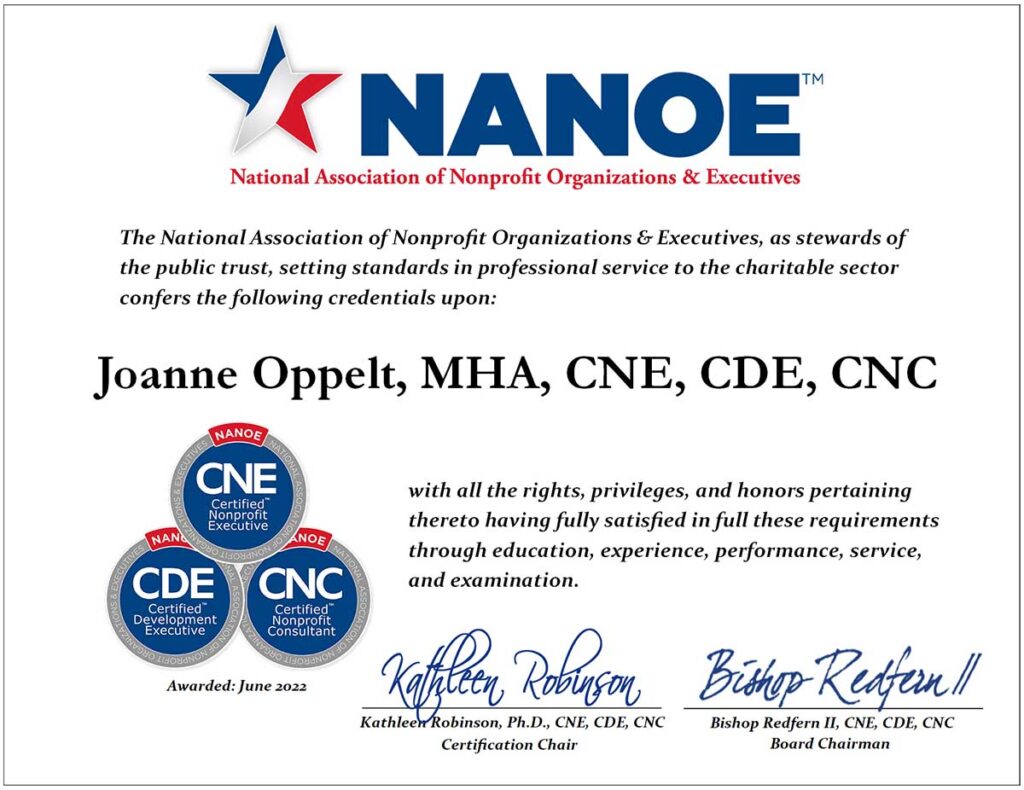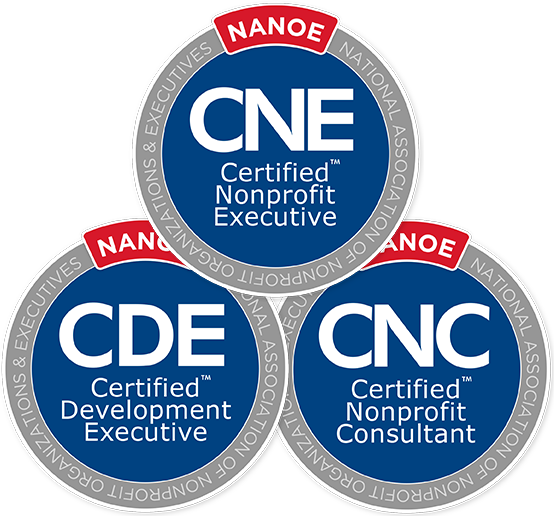Looking For Your Next Job? Get Your Nonprofit Credentials First!
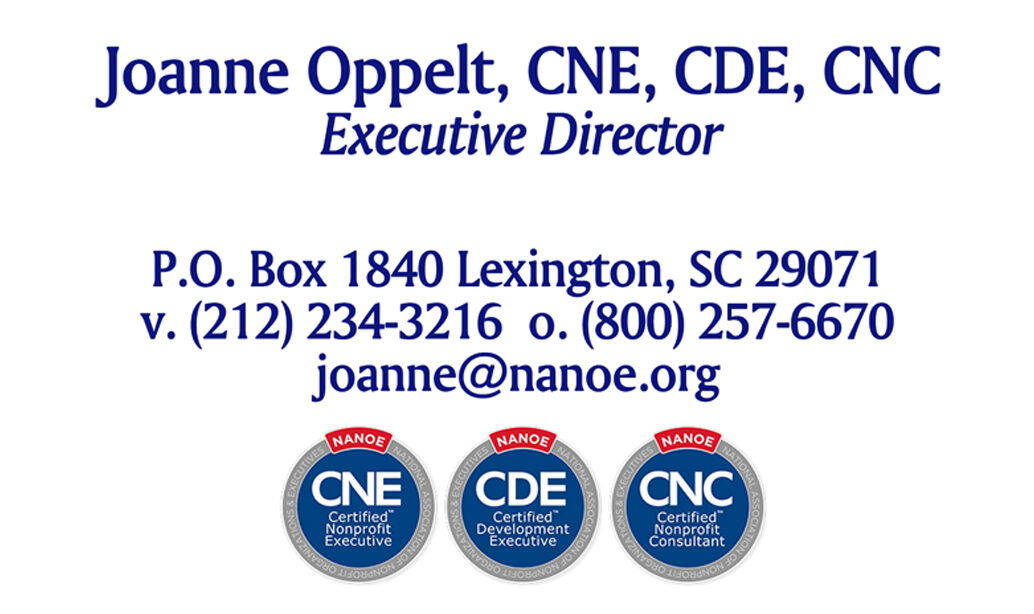
Are you a nonprofit professional who wants to increase your income potential? Do you want to change the world? Do you dream of going for the gold? Then the National Association of Nonprofit Organizations & Executives’ (NANOE) credentialing is for you. It was for me. NANOE Credentialing offers opportunities for career advancement and competitive advantage. Credentials can get you in the door for CEO, Vice-President, Director of Development or other nonprofit leadership positions. Once there, it can increase your chances of a higher salary! So, let’s take a minute to explore NANOE credentials, the research on which it is based, the guidelines it supports, and the outcomes associated with being NANOE certified.
NANOE Credentialing
There are three NANOE credentials you can pursue. The tests are rigorous, and the credentials are highly valued. They are also highly regarded. When you study for the exams, you get a comprehensive view of how an impactful nonprofit works.
VISIT HERE TO GET STARTED ON RECEIVING YOUR NANOE CREDENTIALS
You can pursue one, two, or all three credentials. As a former development and executive director and current consultant, I obtained all three. Upon completion, NANOE sent me a certificate with my credentials which I proudly display in my office.
Certified Nonprofit Executive (CNE) credential (CNE) is designed to help an executive director or CEO grow their agency in all its aspects. Certified Development Executive (CDE) is more geared to the needs of a development officer. It emphasizes revenue generation. The Certified Nonprofit Consultant (CNC) is targeted toward fundraising counsel, intending to deepen a consultant’s practice.
Getting NANOE certified involves familiarity with nonprofit management, experience in nonprofit settings, and completion of an online, multiple-choice, open-book assessment that you have thirty days to complete. Although the exercise sounds easy, it is not. You cannot pass the exams without a good understanding of the accompanying study materials.
A thorough read is well worth your time. It will forever change the way you look at nonprofit capacity building. It did me.
Looking For You Next Job? Get Your Nonprofit Credentials First!
NANOE Research
The reading gets you into the research behind the credentials. NANOE, through the National Development Institute and Clemson University, conducted a multi-year clinical study evaluating charitable outcomes related to capacity building. Four hundred and seventy nonprofit leaders completed a ninety-item, online survey examining their capacity building initiatives. The survey was designed to determine the factors that lead to organizational and missional success.
The study examined leaders’ motivations for building organizational capacity, the organizational dynamics present, and the effects of these two things on nonprofit performance and productivity. Study questions included markers that captured high functioning practices and environments.
Through this study, the researchers discovered which attitudes, social norms, and control beliefs influenced their intention to build capacity. Furthermore, the study analyzed the context in which those beliefs were relevant. The study also identified the environmental factors necessary for capacity building to happen. The result of the study was the creation of the 11,000-page desk reference New Guidelines for Nonprofits.
New Guidelines for Nonprofits
Whatever credential you pursue, you are thrust into New Guidelines for Nonprofits and its clinical research findings. You discover the evidence-based principles that guide nonprofit growth. You understand a new framework for leadership, governance, and fundraising so you don’t get the results of revenues being too small to meet the need. You learn what it takes to be successful.
Specifically, you discover:
1. How to network and engage those inside and outside your organization. The authors define formal and informal networking arrangements, legal structures and agreements, equal and equitable relationships, successful relationship building and communication, and accountability and performance measures. The sections on legal structures and agreements were eye opening for me.
2. The characteristics of a strong CEO. You are taught how to be a maverick that changes the world. The guideline covers how to best structure power in your nonprofit and the role of the board in relation to fundraising and the CEO.
3. How to build financial capacity using traditional nonprofit revenue generation. The guideline talks about earned income, capital acquisition, donor relationships, grants, cooperative agreements, legacy giving, trusts, bargain sales, give-it-twice opportunities, donor advised funds, corporate matching gifts, and gift catalogues. I found this guideline confirmed much of what I already knew while still giving the details I needed to hone my craft.
4. How to boost financial capacity using more nontraditional funding mechanisms. The guideline focuses on different types of capital and how to acquire it. I found the information crucial to understanding the investment mindset of potential high net worth donors.
5. How to evaluate impact in a way that motivates donors to keep giving. The authors speak to the role of an evaluator, evaluating services and operations; outcomes, impacts, inputs, processes and outputs; and operations, leadership and governance structures. They also cover how to develop information systems, use dashboards, build value-based evaluation systems, conduct stakeholder assessments, and partner with key groups to conduct research studies that complement internal evaluations. Talk about proving your impact!
6. How to create a nonprofit that transcends shocks to the sector, including determining purpose and culture. The guideline describes four CEO-driven cultures that work, the breakthroughs they bring, and their drawbacks. If you want to build a strong, sustainable agency, guideline six is a must read.
My goal in the world is to make a difference. The NANOE credentialing process and the benefits if brought helped me achieve my goal. It changed the way I do business forever.
NANOE Credentials Outcomes
New Guidelines for Nonprofits reveals what it takes to scale your mission. To me, this outcome is worth more than the letters behind my name. Finally, I have a guidepost that points me to not only excel at nonprofit management and fundraising, but also excel at true organizational capacity building.
Major Gifts Ramp-Up, the fundraising arm of NANOE, is a practical outgrowth of NANOE research. Although you need not adopt the model to pursue NANOE credentialing, Major Gifts Ramp-Up gives you a system of fundraising that applies the Clemson University research to everyday work life. I am grateful to have found a financial capacity building tool that is evidence based. I use it every day.
You can apply what you learn through the credentialing process to your own agency. The NANOE study materials articulate the factors to succeed like the 15 percent of nonprofit leaders in the Clemson study who built more capacity; grew their budgets, programs and donors; grew their nonprofits regardless of the size or involvement of their board; externalized their mission for the purpose of fundraising; and developed board members who evaluated them and promoted their goals and values.
There are personal benefits too. With a NANOE credential you will:
– Gain credibility by showing that you are a master in the fields of nonprofit leadership, fundraising, and advising.
– Command a higher salary. Research shows that professional credentials are linked to higher salaries.
– Be prepared for an executive level position.
– Move up in your career. Professional development is often linked to job promotions or more responsibility with better pay.
– Be successful in your role.
The moral of the story is to get NANOE Certified. The time you put in is well spent. The benefits are great. It’s a decision that has an immediate payoff. You will be forever grateful.
Looking For Your Next Job? Get Your Nonprofit Credentials First was first posted at NANOE
For more articles like Looking For Your Next Job? Get Your Nonprofit Credentials First VISIT HERE
ABOUT THE JOANNE OPPELT:
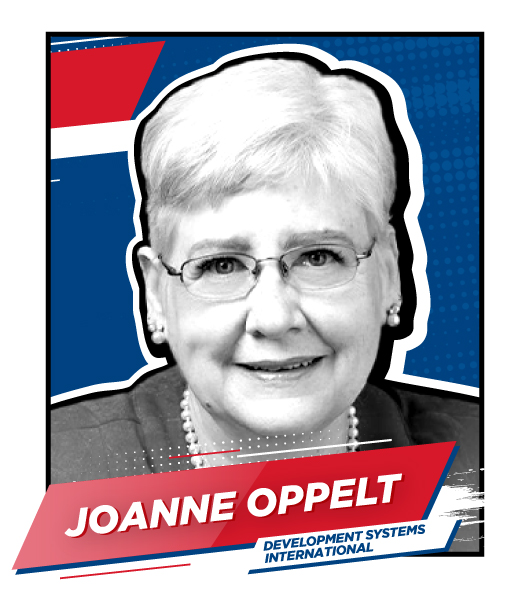 Joanne Oppelt has spent more than thirty years in the nonprofit sector helping large and small nonprofits alike. She has worked across multiple areas including the arts, child welfare, disabilities, early childhood education, maternal and child health, mental health, public health, at-risk youth, and more. She has trained thousands of fundraisers and authored or co-authored more than twenty books on fundraising and nonprofit development. Joanne’s extensive background with such a wide variety of 501(c)(3) organizations has enabled her to have a specialized insight into understanding the challenges nonprofits face both internally and externally. Her years of working in the nonprofit sector have given her the gift of knowing exactly what it takes to run successful fundraising campaigns that are not only completed on time, but also come in under budget and over goal. Joanne holds a B.A. in education from Bethany University and a master’s in health administration from Wilkes University. She is privileged to help charitable organizations significantly impact the world.
Joanne Oppelt has spent more than thirty years in the nonprofit sector helping large and small nonprofits alike. She has worked across multiple areas including the arts, child welfare, disabilities, early childhood education, maternal and child health, mental health, public health, at-risk youth, and more. She has trained thousands of fundraisers and authored or co-authored more than twenty books on fundraising and nonprofit development. Joanne’s extensive background with such a wide variety of 501(c)(3) organizations has enabled her to have a specialized insight into understanding the challenges nonprofits face both internally and externally. Her years of working in the nonprofit sector have given her the gift of knowing exactly what it takes to run successful fundraising campaigns that are not only completed on time, but also come in under budget and over goal. Joanne holds a B.A. in education from Bethany University and a master’s in health administration from Wilkes University. She is privileged to help charitable organizations significantly impact the world.
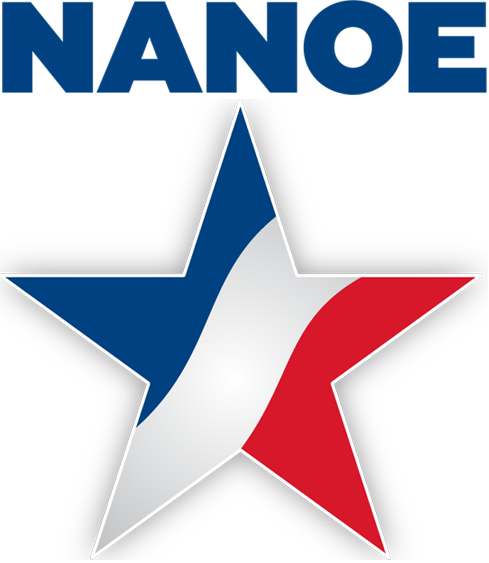
National Association of Nonprofit Organizations & Executives
712 H Street NE Suite 1149
Washington, DC 20002
800-257-6670
[email protected]
